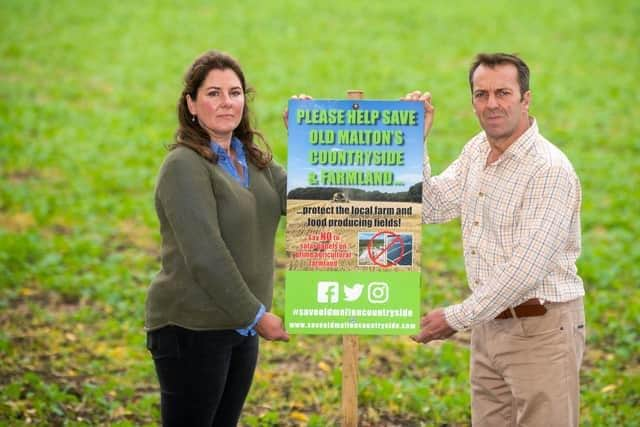Victory for Yorkshire tenant farmer as council set to reject scheme for massive solar farm on prime agricultural land belonging to Fitzwilliam Trust
Residents applauded enthusiastically after a strong majority of North Yorkshire councillors recommended Secretary of State for Levelling Up, Housing and Communities Michael Gove dismisses Harmony Energy’s expansive proposed clean energy scheme on the fringe of Old Malton.
Most councillors said while they wholeheartedly supported efforts to increase renewable energy schemes in the area, they remained unconvinced the proposed site off Great Sike Road was the only alternative place.
Advertisement
Hide AdAdvertisement
Hide AdThe meeting heard although radical steps were needed to bolster clean energy production councillors would increasingly face difficult decisions unless energy use fell.


A Harmony Energy spokeswoman had told members the proposed development would supply 8,660 properties – some 38 per cent of the homes in Ryedale – with clean energy and the area the solar panels would cover represented a tiny fraction of the land in Yorkshire used to grow crops.
The meeting heard claims the 130-acre plot was the only site close enough to a substation to meet Norhtern Powergrid’s requirements and to make the venture viable.
Harmony Energy then urged councillors to give significant weight to the fact the solar farm was ready to be constructed, with the firm having secured a viable Grid connection with Northern Powergrid.
Advertisement
Hide AdAdvertisement
Hide AdOther benefits, the spokeswoman added, included a 105 per cent bidoversity net gain and 12,500 tonnes of annual carbon dioxide savings.
The meeting heard the site’s landlord, the Fitzwilliam Trust Corporation, had “every legal right to progress the scheme” and while Harmony Energy did not discredit the concerns of the farmer, it was primarily a commercial issue.
Speaking on behalf of some 500 objectors, deputy mayor of Malton, Councillor Lindsay Burr, told the meeting the use of best and most versatile land must be resisted and the scheme would have a “huge visual impact”.
She told members: “It is shameful turning this area into an industrial site. North Yorkshire Council must listen to local residents.”
Advertisement
Hide AdAdvertisement
Hide AdIn an emotionally-charged speech, the tenant farmer of much of the proposed site, Robert Sturdy, said if the scheme was approved, his landlord would be able to evict him from 110 acres of the 280-acre holding he had farmed for 35 years.
Mr Sturdy’s grandfather arrived at the farm in 1954 and his later father, John, took over in 1971. He has run the farm since 2014 and now lives there with his wife and their two children.
He implored the committee to reject the proposal, saying it would “destroy everything I have worked my entire life for”.
Mr Sturdy said: “The crops need good soil to thrive. Food production is as important as energy production.”
Advertisement
Hide AdAdvertisement
Hide AdHe told members in a good year his land, much of which had been graded as being of a top quality for agriculture, produced enough crops to produce one million loaves of bread and their decision would be a defining moment for the sector.
Officers said while tests to consider alternative sites had “not been satisfactorily met”, the proposal would deliver a significant public benefit in terms of renewable energy that outweighed concerns of increasing flood risk in the area.
They underlined the urgent need to bring forward renewable energy schemes as quickly as possible to meet government targets.
For much of the meeting the scores of residents attending the meeting watched proceedings in silence. However, when the committee was told the 40-year lifetime of the solar farm made it acceptable as it was “temporary”, numerous people in the public gallery laughed in derision.
Advertisement
Hide AdAdvertisement
Hide AdAs councillors repeatedly questioned whether alternative sites had been properly investigated, the meeting heard the council had not considered the financial harm it would cause to Mr Sturdy’s farm or the cost of relocating the solar farm to a site further away from the Old Malton substation.
Boroughbridge councillor Robert Windass said: “This is some of the best land we are cutting out for 40 years. Does the solar farm have to be positioned on such great agricultural land?”
Councillors said the plan was good, but it was in the wrong place, and that it would be much better to generate solar power on roofs.
Proposing the scheme be rejected, Upper Dales councillor Yvonne Peacock said: “We are all looking for Co2 reduction, but we have got to remember we are a very small island and we need food. Food could end up being scarce in future. We have got to be very careful we are not taking away the agricultural land we need for food.”
Advertisement
Hide AdAdvertisement
Hide AdThe Earls Fitzwilliams’ estates in Malton were divided in 1948 after the death of the last earl without a male heir. His daughter, Lady Juliet Tadgell, owns property and agricultural land in Old Malton through the Fitzwilliam Trust Corporation. The commercial area of the market town of Malton is in the hands of the Naylor-Leyland branch of the family as the Fitzwilliam Malton Estate.
